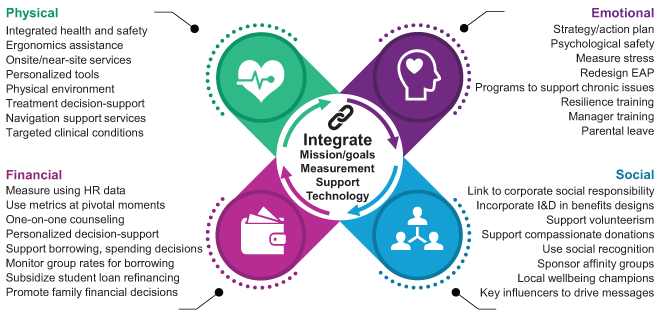6 steps to ensure employee well-being in your company

Peak functionality … but physical well-being is only one of four types employers should consider.
Image: Luis Quintaro
Laura Sejen
Managing director, human capital and benefits integrated solutions leader, Willis Towers WatsonStay up to date:
Health and Healthcare
Should employers be concerned with the well-being of their employees?
The answer, of course, is yes. A workforce that is “well” leads to increased productivity. But research has uncovered a startling disconnect between employer and employee perceptions of employee well-being. More than half of employers (56%) believe their well-being programs have encouraged employees to live healthier lifestyles, but less than one in three employees (32%) agrees, according to our Global Benefits Attitudes Survey.
We looked at the Net Promoter Score (a widely used index of customer satisfaction ranging from -100 to 100) to assess the likelihood that employees would recommend their employers' health and well-being initiatives and activities to their colleagues. In every country except India, the detractors outweighed the promoters, typically by substantial margins. Clearly, employer well-being programs to date are missing the mark for employees, particularly in North America, Europe, the Middle East and Africa (EMEA).

Why do employee well-being programs fail?
Employees are looking for more than financial incentives when it comes to participating in employer-sponsored health screenings or savings vehicles. Instead, they want to feel these types of programs and tools meet their needs as individuals and connect to them in a deeper, more meaningful way.
Well-being is not an isolated program or initiative. Employee well-being is purpose-driven and woven into the fabric of an organization’s values and the employee experience. It is inextricably linked to a myriad of policies, programs and benefit offerings as well as to desired culture, productivity improvement, longer-term organizational talent retention and sustainability of business results.
Four dimensions of integrated well-being
We believe an integrated approach that encompasses four dimensions of employee well-being – physical, financial, emotional and social – is the key to creating greater employee engagement.
1. Physical well-being: To thrive physically means understanding and managing one’s health, taking appropriate preventive measures, improving health status where needed, managing chronic conditions, navigating and recovering from an acute illness or unexpected injury, and successfully returning to peak functionality at home and at work.
2. Emotional well-being: Being emotionally balanced means being self-aware, maintaining good mental health, being resilient by managing stress, coping with positive and negative emotional triggers, dealing with life crises and maintaining stability through illness or injury.
3. Financial well-being: Achieving the state of being financially secure means having the ability to manage budgetary commitments, meet financial goals, protect against risks, save for contingencies or future needs like college or retirement and cope with financial shocks.
4. Social well-being: Social employee well-being is about being connected by understanding how to interact well with others, accepting diversity, being inclusive, knowing how to support and collaborate with others, being able to successfully resolve conflicts and adapting to change. Being connected applies across one’s family and friends, one’s workplace and the larger community.
Each dimension is unique and intertwined with the others. Integrated well-being begins with individuals and, when achieved, extends throughout their organizations, families and the larger community. As a result, the ideal state of well-being ⎯ physically thriving, emotionally balanced, financially secure and socially connected ⎯ places the employee at the center and is truly integrated across all four dimensions.
How do you connect these four well-being dimensions for employees?
Through our extensive interactions with employers, we’ve found that they truly believe that employee well-being is important and will indeed improve financial results as well as talent retention. As with other areas of total rewards, such as benefits, they are making the shift toward being less paternalistic. We see more customization being offered: for example, a defined contribution approach (as opposed to a defined benefit prescribed by the employer), in which employees can choose from a menu of well-being programs that make sense for them, much as they do with health or retirement plans.
Companies can implement a more personalized, integrated approach to employee well-being by following these six steps:
1. Assess where your company is currently in terms of addressing each of the four dimensions of well-being defined above. Consider both the employee perspective as well as your leadership’s point of view. For example, when it comes to physical well-being, your company may integrate workplace safety and well-being strategy and programs, but may not be delivering programs or pilots that target specific conditions or high-cost cases that employees are looking for.
2. Set goals and objectives to help close the gaps identified in your assessment and develop guiding principles for design and prioritization of your strategy. For example, you may want to set and track specific metrics for financial employee well-being programs at pivotal financial decision points and then offer one-on-one counseling at employees’ critical junctures if you find these programs are being underutilized.
3. Design your well-being program. Consider decision support and educational tools across each of the key dimensions. For example, for emotional well-being programs, consider decision support tools to help employees find the right behavioral health provider or treatment facilities.
4. Consider vendor solutions and software tools to implement programs you determine are needed across each dimension. For example, diet and exercise tracking for physical; retirement counseling sessions for financial; employee assistance programs for emotional; eLearning platforms to promote positive workplace culture and diversity initiatives for social.
5. Implement processes for managing vendors and tracking progress. For example, require vendors to share data for employee referrals and integrated reporting. Use single sign-on technology to enable employees to easily access various vendors through one benefits portal.
6. Engage employees through campaigns, training, ongoing communications and the rollout of individualized solutions. For example, use social recognition such as designating local champions for community initiatives, and your company intranet to promote photos and stories of employee participation in activities.
The graphic below illustrates a number of other ways to consider the various components of employee well-being as part of an integrated strategy.

An integrated approach to employee well-being means moving away from buzzwords and gestures to finding solutions that can meet employees where they are. It means creating a culture that supports and respects employees as individuals (e.g., inclusion and diversity, community involvement, corporate social responsibility, etc.) And it means planning for the lifespan of your employees, not just the next year. Over time, their needs will change, so you need to design programs that will evolve as they do.
Well-being matters; how your employees feel influences how and where they work. It also influences productivity and ultimately financial results. Moreover, having employees who are thriving, secure, balanced and connected can not only help to improve the workforce, but also the world as we know it.
Don't miss any update on this topic
Create a free account and access your personalized content collection with our latest publications and analyses.
License and Republishing
World Economic Forum articles may be republished in accordance with the Creative Commons Attribution-NonCommercial-NoDerivatives 4.0 International Public License, and in accordance with our Terms of Use.
The views expressed in this article are those of the author alone and not the World Economic Forum.
Related topics:
Forum Stories newsletter
Bringing you weekly curated insights and analysis on the global issues that matter.
More on Jobs and the Future of WorkSee all
Katica Roy
July 23, 2025
Babak Hodjat
July 11, 2025
Majlinda Bregu
July 9, 2025
Shakthi M Nagappan
July 7, 2025




